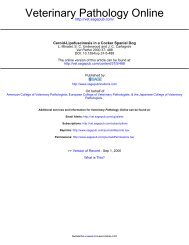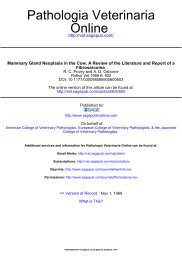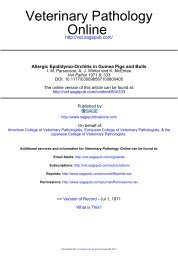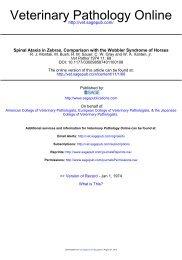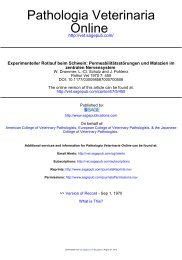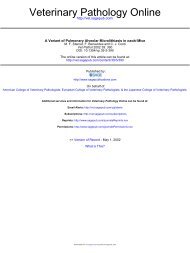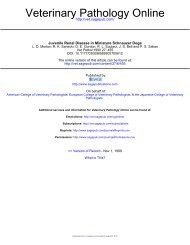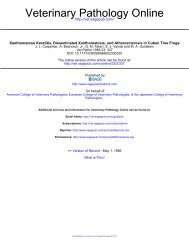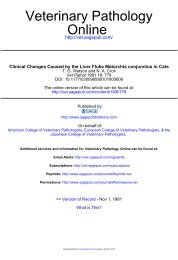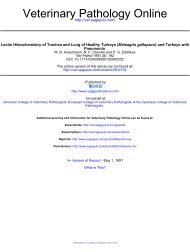Histopathologic Features and Post-surgical Sequelae
Histopathologic Features and Post-surgical Sequelae
Histopathologic Features and Post-surgical Sequelae
Create successful ePaper yourself
Turn your PDF publications into a flip-book with our unique Google optimized e-Paper software.
Vet !'ath ol 30:6. 1993 Skin Tumors in Ferrets 503<br />
The preputial gl<strong>and</strong> <strong>and</strong> anal gl<strong>and</strong> neoplasm s were<br />
compatible with apocrine gl<strong>and</strong> adenocarcino mas. The<br />
preputial gl<strong>and</strong> ade nocarcino ma was inoperabl e, <strong>and</strong><br />
the animal was eutha natized. T here was no reported<br />
recurre nce or metastasis of the ana l gl<strong>and</strong> adc nocarcmo<br />
rna.<br />
The preputial lym phosarco ma (tumor No . 56) was<br />
a 2-cm -diame ter ulcerat ed mass involving the prepuce,<br />
but not the peni s, of a 6-year-old intact male. Microscopically,<br />
the prepuce <strong>and</strong> inguinal lymph node had<br />
sheets ofindividualized round neoplastic cells that had<br />
a small amount of cytoplasm , coarsely clumped chroma<br />
tin , promi nent nu cleoli, <strong>and</strong> num erous mitoti c figures<br />
that were co mpatible with th ose of mod erately<br />
differentiated Iymphoblasts. <strong>Post</strong>-operat ive clin ical inform<br />
ati on was not available.<br />
Th e cuta neo us polyp (tumor No . 57) was a 3-mmd<br />
iame ter mass on the right metat arsus of a 5-year-old<br />
fem ale. Microscopica lly, the polypoid lesion consisted<br />
ofa central zo ne offibrous connective tissue <strong>and</strong> blood<br />
vessels covered by well-differentiated stratified squamou<br />
s epithelium . T here was no reported recurrence or<br />
me tas tasis.<br />
Discussion<br />
Cutaneous neopl asm s were co m mo n findin gs in biopsy<br />
or necrop sy speci me ns fro m dom estic ferrets submitted<br />
to diagnostic lab oratories <strong>and</strong> comprised 46%<br />
of accessions in a 54-mont h period. T he mos t common<br />
cutaneous neopl asm in th is study was basal cell tumor<br />
33/57 (58%), followed by mastocytoma 9/57 ( 16%) <strong>and</strong><br />
fibro ma 6/57 (I I%). Previo us case reports 9. 11. 15.22 have<br />
suggested that cutaneous squamous cell carci noma is<br />
co m mo n in ferrets, no squa mo us cell carcino mas were<br />
found in the present study. Th e grea t majorit y of the<br />
basal cell tumors in this study included areas o f squamous<br />
differe ntiation , but the basaloid components were<br />
so prominent that the neop lasm s would not be c1assilled<br />
as squamous cell carci no ma s by accepted classificatio<br />
n criteria.<br />
T he basal cell neoplasms were micro scopically similar<br />
to those seen in dogs '? <strong>and</strong> to the ferre t neoplasm s<br />
previou sly reported as basisqu amosebaceou s <strong>and</strong> sebaceou<br />
s gl<strong>and</strong> carcino mas. 19.20 T hese two term s are descriptive<br />
of many of the lesion s seen in th e present<br />
study , but the term " basal cell tumor " was chose n to<br />
reflect the co m mo n origin ofthe tumors fro m basaloid<br />
ep ithelial cells. There were no pigm ent ed or cystic basal<br />
cell tumors, such as th ose seen in dom estic cats.v"<br />
There was no distinct site predilection, altho ugh the<br />
head, neck, sho ulders , legs, <strong>and</strong> feet were somewhat<br />
more commonly involved than expected, give n the<br />
relative surface area of ski n involved. In the overall<br />
gro up of 142 ferrets with cuta neo us <strong>and</strong> noncutan eou s<br />
Downloaded from<br />
vet.sagepub.com by guest on February 8, 2013<br />
lesions, 58% were females, but 70% offerrets with basal<br />
cell tumors were female.<br />
T he ma stocytomas were microscopically benign <strong>and</strong><br />
were sim ilar to th ose previou sly reported in ferr ets.<br />
T he mastocytomas were simi lar to th ose seen in domestic<br />
cats, although the ferret lesion s lacked the follicular<br />
lymphocytic aggregatio ns that are commonly<br />
seen in solitary cuta neo us mastocyto mas of cats.P-"<br />
T he sing le multicentric histiocytic mastocytoma resembled<br />
the histiocytic variant of mastocytoma that<br />
is most commo nly seen in Siamese cats." The ferret<br />
mastocytomas lacked the prom inent eosinophilic infiltratio<br />
n, ede ma , <strong>and</strong> collagen dege neratio n that are<br />
commonly seen in canine cuta neo us mastocytomas."<br />
Mast cell gra nules of rode nts <strong>and</strong> human beings have<br />
an a ffi nity for av idi n th at can be dem on strat ed by sta ndard<br />
immunohi stochemi cal sta ining procedures.v' <strong>and</strong><br />
avidin affinity has been reported as a method for differen<br />
tia ting mastocytomas from other ro und cell tu <br />
mors in the dog <strong>and</strong> ca1. 3 • 18 Findings in the present<br />
stud y indicate that some ferre t mas tocytomas have<br />
affini ty for avi din; however, avi di n stai ning had no<br />
d iagnostic advantage over ro utine staining wit h toluidine<br />
blue for me tachromasia.<br />
T he fibro mas <strong>and</strong> fibrosarcomas were simi lar to those<br />
reported in other species. The degree of cellular atypism<br />
<strong>and</strong> mitoti c ind ex were th e basis for classificati on<br />
oftwo masses as fibrosa rcomas, although th ose lesio ns<br />
d id not appear to be highly aggressive.<br />
T his study provides no conclusive information regarding<br />
the overall prevalence ofneoplasia in the ferre t<br />
beca use the size of the general population from whic h<br />
these cases were derived was unknown. Cutaneous neoplasms<br />
were commonly found among speci me ns subm<br />
itted for ro utine histopath ologic diagnos is, but specime<br />
ns ofthat type would be expected to contai n a large<br />
percentage of neopl asm s. Th ese features of th e study<br />
prohibit us from confirmi ng or refuti ng the prop osal<br />
th at the ferre t is a low tumor incidence species.<br />
References<br />
And rews PL, Illman 0, Mell crsh A: Some o bserva tions<br />
o r anato m ica l abnormalities <strong>and</strong> d isease stat es in a population<br />
or350 ferrets (Mu stela furo L.) . Z Versuchstierkd<br />
21:346-353, 197 9<br />
2 Bergstresser PR, T igclaar RE, T harp MD: Conj ugated<br />
avidin iden tified cutaneous rodent <strong>and</strong> human mast cells.<br />
.I Invest Dermato I 83:2 l4 - 2 18, 1984<br />
3 Bo lon 13, Calderwood Mays MB: Conj ugated av idinpero<br />
xidase as a stai n for ma st cell tumors. Vet Pat hol<br />
25: 523-525 , 1988<br />
4 Bussolati G , G ugliotta P: Non specific sta ining or ma st<br />
cells by avid in-bi otin-peroxid ase co m plexes (ABC). .I<br />
Histochem Cytoc hem 3 1: 14 19-1421, 1983<br />
5 Carpenter .JW, Novilla MN : Diabetes me llitu s in a blacklo<br />
oted ferret. .I Am Vet Med Assoc 171: 890- 893, 1977



